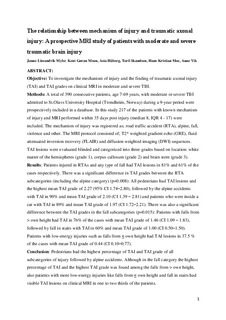The relationship between mechanism of injury and traumatic axonal injury : a prospective MRI study of patients with moderate and severe traumatic brain injury
| dc.contributor.advisor | Vik, Anne | |
| dc.contributor.author | Myhr, Janne Limandvik | |
| dc.date.accessioned | 2016-11-07T08:14:13Z | |
| dc.date.available | 2016-11-07T08:14:13Z | |
| dc.date.issued | 2016 | |
| dc.identifier.uri | http://hdl.handle.net/11250/2419652 | |
| dc.description.abstract | Objective: To investigate the mechanism of injury and the finding of traumatic axonal injury (TAI) and TAI grades on clinical MRI in moderate and severe TBI. Methods: A total of 390 consecutive patients, age 7-69 years, with moderate or severe TBI admitted to St.Olavs University Hospital (Trondheim, Norway) during a 9-year period were prospectively included in a database. In this study 217 of the patients with known mechanism of injury and MRI performed within 35 days post injury (median 8, IQR 4 - 17) were included. The mechanism of injury was registered as; road traffic accident (RTA), alpine, fall, violence and other. The MRI protocol consisted of; T2* weighted gradient echo (GRE), fluid attenuated inversion recovery (FLAIR) and diffusion weighted imaging (DWI) sequences. TAI lesions were evaluated blinded and categorized into three grades based on location: white matter of the hemispheres (grade 1), corpus callosum (grade 2) and brain stem (grade 3). Results: Patients injured in RTAs and any type of fall had TAI lesions in 81% and 61% of the cases respectively. There was a significant difference in TAI grades between the RTA subcategories (including the alpine category) (p=0.008): All pedestrians had TAI lesions and the highest mean TAI grade of 2.27 (95% CI 1.74–2.80), followed by the alpine accidents with TAI in 90% and mean TAI grade of 2.10 (CI 1.39 – 2.81) and patients who were inside a car with TAI in 89% and mean TAI grade of 1.97 (CI 1.72–2.21). There was also a significant difference between the TAI grades in the fall subcategories (p=0.015): Patients with falls from > own height had TAI in 76% of the cases with mean TAI grade of 1.46 (CI 1.09 – 1.83), followed by fall in stairs with TAI in 60% and mean TAI grade of 1.00 (CI 0.50–1.50). Patients with low-energy injuries such as falls from ≤ own height had TAI lesions in 37.5 % of the cases with mean TAI grade of 0.44 (CI 0.10–0.77). Conclusion: Pedestrians had the highest percentage of TAI and TAI grade of all subcategories of injury followed by alpine accidents. Although in the fall category the highest percentage of TAI and the highest TAI grade was found among the falls from > own height, also patients with more low-energy injuries like falls from ≤ own height and fall in stairs had visible TAI lesions on clinical MRI in one to two thirds of the patients. | nb_NO |
| dc.language.iso | eng | nb_NO |
| dc.publisher | NTNU | nb_NO |
| dc.subject | traffic accidents | nb_NO |
| dc.subject | magnetic resonance imaging (MRI) | nb_NO |
| dc.subject | traumatic brain injury (TBI) | nb_NO |
| dc.subject | diffuse axonal injury | nb_NO |
| dc.subject | cohort study | nb_NO |
| dc.subject | prospective study | nb_NO |
| dc.title | The relationship between mechanism of injury and traumatic axonal injury : a prospective MRI study of patients with moderate and severe traumatic brain injury | nb_NO |
| dc.type | Master thesis | nb_NO |
| dc.subject.nsi | VDP::Medical disciplines: 700 | nb_NO |
